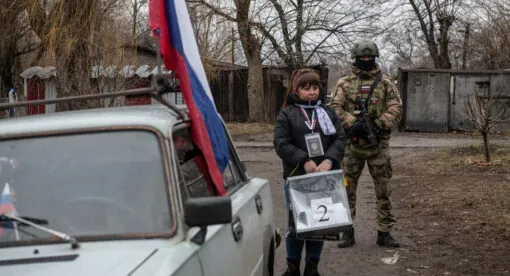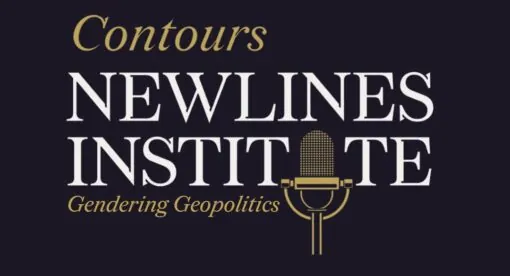Editor’s Note: This Terrain Analysis is part nine of “ISIS 2020” – a series of briefings about the current status of the Islamic State by authors from different parts of the region. It is published by the Newlines Institute‘s Nonstate Actors program. Parts one, two, three, four, five, six, seven, and eight were released on April 28, May 5, May 12, May 19, May 26, June 2, and June 4, respectively.
Islamic State Khorasan (ISIS-K), the Islamic State’s branch in Afghanistan and Pakistan, arose in early 2015 in perhaps one of the most volatile geopolitical environments in the world. A war-torn Afghanistan with a prolonged U.S. military presence, a fledgling government heavily dependent on external aid, and an amphitheater for competing regional interests proved to be an optimal environment for ISIS-K to establish itself as a durable entity. While sustained counterterrorism efforts by U.S. and Afghan forces and intense clashes with the Afghan Taliban constrained the group in recent years, the U.S. withdrawal and continued political uncertainty in Afghanistan appears to have given the group a new resolve to disrupt the ongoing peace process.
Given ISIS-K’s demonstrated resilience and operational capacity in the past, the risks associated with a revived ISIS-K are too grave to disregard. Increasingly provocative attacks could seed mistrust amongst Afghan actors and impede political and socio-economic advancements, which may facilitate the group’s recruitment of discontented militants, connections with opportunistic militant groups, and acquisition of territorial strongholds. Such developments not only threaten U.S. interests in the region but also increase the likelihood of proxy warfare in Afghanistan. In this context, sustained international support for counterterrorism efforts against ISIS-K in Afghanistan are important in the short and medium term, as well as long-term meaningful regional security cooperation amongst Afghanistan’s neighbors to dismantle the group’s network and thwart its recruitment efforts. In parallel, both U.S. and regional states’ support for socio-economic and political progress remains critical to diminish the ideological influence of extremist groups like ISIS-K.
ISIS-K has marked its sixth year of existence with notable violence. A cluster of attacks linked to the nearly decimated group in the first half of 2020 garnered publicity and seemed to disrupt the tenuous peace process in Afghanistan. Among others, these attacks included a six-hour siege of a Sikh gurdwara in Kabul and an attack on Afghan President Ashraf Ghani’s inauguration ceremony, both in March, and a suicide attack in Nangarhar on a police commander’s funeral in May. The latter coincided with an attack on a maternity ward in Kabul, which was attributed to ISIS-K by U.S. government officials, although the group has not claimed responsibility for it. ISIS-K has a strong record of sustaining violence in arduous circumstances; for now, it appears determined to stoke political volatility in Afghanistan through a surge of violence against state actors and civilians.
The Dangers Associated with a Resurgent ISIS-K
In the years since its official emergence in 2015, ISIS-K has carved out space for itself in the region by recruiting heavily from pre-existing militant groups, forming operational alliances while confronting rivals, and inflicting heavy causalities through the use of suicide attacks. However, intensive counterterrorism efforts against the group have resulted in significant manpower and territorial losses. Enervated by its losses, ISIS-K in 2020 appears to be on a mission to be ever more provocative to exacerbate the fragile situation in Afghanistan; doing so would help create an environment where it can survive and remain relevant. While ISIS-K has a history of killing civilians and state personnel in the Afghanistan-Pakistan region, including sectarian attacks against the Shiite and Sunni Barelvi Sufi communities, its recent wave of violence comes at a particularly critical and sensitive juncture. Violence perpetrated by ISIS-K doesn’t just exacerbate general instability in the region, it directly threatens to unravel the peace process in Afghanistan between the United States and the Taliban and, subsequently, a power-sharing agreement within Afghanistan.

The attack on a Doctors Without Borders maternity ward in Kabul in a Hazara Shiite community, which was assessed by the United States to have been executed by ISIS-K, serves as a case in point. Despite the Taliban’s public denial of any involvement in the attack, the Afghan government directed blame toward the Taliban and announced resumption of offensive operations against the group. Ultimately, whether the Islamic State was involved in conducting the hospital attack or not, the event illustrates two important points. First, it shows how provocative terrorist attacks can unravel political gains by sowing discord and mistrust amongst Afghan actors and steer the country towards instability. Second, it demonstrates how any discontinuities in sustained counterterrorism pressure against militants motivated to disrupt the peace process can create such opportunities.

This is not to imply that ISIS-K retains the organizational strength it once did, given its heavy losses including the arrests of two top leaders. But having less to lose means that the group’s heightened desperation to survive is likely to manifest itself in the form of even more shocking attacks to attract publicity and generate the instability it needs to persist. The security consequences of ISIS-K’s activity in Afghanistan and Pakistan are not confined to the domestic sphere, such as those typically associated with other local militant organizations like the Pakistan-based Lashkar-e-Taiba (LeT), which is focused on waging a jihadist insurgency in Kashmir, or the deeply anti-Shiite group Lashkar-e-Jhangvi (LeJ). ISIS-K’s existence in the region entails international security implications; by virtue of being a prominent branch of a durable transnational brand, its goals are underpinned by an ideology that transcends national borders and often overlaps with those of other militant groups. This creates room for tactical and strategic cooperation with several different lethal groups. ISIS-K’s resurgence can also provide an attractive base for foreign fighters looking for a new conflict theatre. Finally, the sectarian nature of ISIS-K’s targeting choices can significantly exacerbate sectarian violence in the region and be informed by the growing Iranian-Saudi proxy conflict.
Understanding ISIS-K’s Strengths and Weaknesses
Examining ISIS-K’s behavior over the past five years indicates that the group’s strategy to set up shop in the region was shaped by two factors: the political environments within Afghanistan and Pakistan and the militant milieu in each country. Pakistan, which has a strong military but a variety of active militant groups and a porous border with pockets of safe havens in the Federally Administered Tribal Areas and Balochistan, was expedient to use as a logistical hub for the group. ISIS-K fostered relationships with groups that possessed locally relevant skills and knowledge such as LeJ, Jamaat-ul-Ahrar, and Lashkar-e-Islam, and it sought to absorb beleaguered Tehrik-i-Taliban Pakistan (TTP) factions.
In Afghanistan, ISIS-K’s main operational base, the group not only positioned itself against the Afghan government and coalition forces but also sought to delegitimize the Afghan Taliban as a means to create space for itself. The Afghan Taliban’s engagement in the peace process has only justified ISIS-K’s critique of them as a group that is nationalistic in nature, and thus seeks an emirate as opposed to the caliphate and acts as an agent of Pakistan akin to LeT.
The Islamic State’s Jammu and Kashmir (ISJK) branch, which was announced in early 2016, sought a similar strategy; it positioned itself against groups like LeT with passive or active state support, as well as the Indian state, and sought to appeal to the grievances of the Kashmiri population. Islamic State propaganda directed toward a Kashmiri audience runs parallel to al Qaeda’s efforts to influence the Kashmiri insurgency since the early 2000s and delegitimize Pakistan-linked militant proxies. While al Qaeda has had limited success in building an operational base in Kashmir, it has ideologically influenced groups such as Harkat-ul-Jihad-al-Islami and Jaish-e-Mohammed and created a Kashmir-based affiliate, Ansar Ghazwat-ul-Hind. Both al Qaeda and the Islamic State continue their efforts to exploit the grievances of the Kashmiri and Indian Muslim populations for recruitment and to infuse local forms of jihadism with transnational tones.
Since at least 2016, ISIS-K has suffered a significant number of manpower losses, including many of its top and mid-tier leaders, in counterterrorism operations, which, combined with the dismantling of its Nangarhar stronghold, led the Afghan government to declare the group as defeated in late 2019. Nevertheless, there were significant concerns that many ISIS-K militants and leaders had simply been dispersed, which always presents a risk of resurgence. Despite such losses, a close examination of ISIS-K’s operational trajectory shows that although the group’s lethality per attack dropped significantly post-2017 in Pakistan and has remained low thereafter, in Afghanistan it increased sharply after 2017 and remains high in 2020.

ISIS-K’s strengths are firmly rooted in its expansive network and its ability to draw experienced fighters from rival groups like the TTP, the Afghan Taliban, and LeT, especially for leadership positions. Its ability to operate on both sides of the Afghanistan-Pakistan border and tap into grievances directed toward multiple state actors has provided it with a fertile ground to sustain itself.
Perhaps in an attempt to respond to local dynamics with more agility, or even preempt factional disputes, organizational changes resulted in the emergence of Islamic State-Pakistan and Islamic State-Hind (India) in May 2019. The establishment of multiple country-level Islamic State branches in South-Central Asia may be an attempt to augment each branch’s ties with local developments and grievances, which could facilitate recruitment, propaganda, and networks at the local level. Although so far the Pakistan and Hind branches have only claimed responsibility for small-scale attacks, any interlinkages and resource-sharing between the branches could pose a formidable challenge for regional security as it extends the space where Islamic State must be countered. Islamic State propaganda has increasingly focused on exploiting rising tensions between Indian Muslims and Hindus in a bid to attract Indian Muslims to join the Islamic State. Moreover, one of the terrorists involved in the Gurdwara attack on March 25 included Abu Khalid al-Hindi, suspected to be from the state of Kerala in India. Per an Islamic State statement, the attack was “revenge for the Muslims in Kashmir.”
ISIS-K in an Evolving Regional Environment
In the near future, various developments in the region are likely to impact the evolution of ISIS-K’s goals, strategies, and tactics. The immediate U.S. need is to ensure that ISIS-K’s operations do not disrupt the peace agreement with the Taliban or intra-Afghan talks. In the event of a successful power-sharing agreement, the ruling Afghan government will need to disrupt ISIS-K’s recruitment efforts and reinforce territorial control in areas of weak governance, which are likely to be ISIS-K’s lifelines. Any power-sharing agreement is likely to create resentful militants who may be swayed to join ISIS-K. Extending the writ of the state across all of Afghanistan’s districts has historically been a formidable task, but it will be critical to prevent ISIS-K’s attempts to re-establish physical strongholds. In Pakistan, ISIS-K’s presence in Balochistan needs to be tackled more forcefully where it continues to operate, and the group’s operational alliances need to be dismantled. Part of ISIS-K’s strength in Pakistan will also be shaped by the evolution of the TTP, which remains aligned organizationally with the Afghan Taliban, though recent efforts to reinvigorate itself and regroup in Pakistan’s tribal areas may create increased room for opportunistic cooperation, especially if it refuses to give up arms against the Pakistani state.
Another important dimension is the broader dynamics of proxy warfare in the region. In the aftermath of the January 2020 killing of Iranian Maj. Gen. Qasem Soleimani’s killing in January 2020, Iran may strategically employ its proxies in the region to buttress its influence. Soleimani headed the Islamic Revolutionary Guard Corps’ (IRGC) elite overseas operations arm, the Quds Force, and his death has thrust to the forefront his deputy, Brig. Gen. Esmail Qaani, who has been entrenched in Iran’s strategy in Afghanistan and in recruitment efforts in Pakistan. A U.S. troop drawdown, Iran’s aspirations to fortify influence in Afghanistan, and heightened tensions with Pakistan are all likely to impact Iran’s use of proxies in the region, which will have implications for ISIS-K’s evolution. ISIS-K’s deeply anti-Shiite ideology, which aligns with Islamic State’s general principles of targeting minority sects, positions Iran and its Shiite proxies staunchly against ISIS-K. Moreover, Iran also shares ethnic, religious, and political links with the Shiite Hazara community in Afghanistan, which has been a target of ISIS-K’s attacks over the years.
Iran has been slowly cultivating a cooperative relationship with the Afghan Taliban and has contributed toward stabilizing Afghanistan through foreign direct investment and communications and transport infrastructure, becoming the country’s largest trade partner in 2018. In the past two decades, a mix of Afghan insurgents, including Taliban factions, have reportedly received resources from Iran, in the form of weapons and funding through the Quds Force, to counter U.S. efforts. In February 2011, British forces intercepted a consignment of 122 mm rockets in three trucks entering Afghanistan’s southwestern Nimruz Province. In addition to its animosity toward the United States, part of Iran’s support for the Afghan Taliban has been driven by its goals to constrain ISIS-K. In 2018, the IRGC released a report via its affiliated Tasnim News that delineated how the Taliban was an effective entity against ISIS-K. The Taliban’s relations with Iran improved especially under the leadership of Taliban leader Mullah Akhtar Mohammad Mansour, partially motivated by an attempt to minimize Pakistan’s influence.
Amongst the proxy groups that Iran has cultivated, the one with close connections to Afghanistan is the Liwa Fatemiyoun. Formed in 2014, the group is primarily made up of Afghan Hazaras and is estimated to consist of between 10,000 and 20,000 fighters, providing a resistance to transnational Sunni jihadism. In November 2017, Deputy Afghan Chief Executive Mohammad Mohaqiq confirmed that Iran had indeed recruited fighters in the thousands from Afghanistan and other regions to fight in Syria. Additionally, there is its Pakistani counterpart, known as Liwa Zainebiyoun, or Zeynabiyoun Brigade, which draws many of its fighters from Pakistan’s Kurram district. Iran’s recruitment from Pakistan has exacerbated sectarian violence in Pakistan: In December 2015 LeJ, which maintains operational links with ISIS-K, conducted an attack in Kurram district and warned of more attacks “if the people in Parachinar did not stop sending people to take part in Syrian war.”
But how likely is Iran to use its proxies with links to Afghanistan and Pakistan in South and Central Asia, and to counter ISIS-K? Some have speculated that Iran may redeploy its Fatemiyoun and Zainebiyoun fighters to Afghanistan and Pakistan, respectively. This remains uncertain since doing so involves significant geopolitical risks given Iran’s tense relationship with the United States, Saudi Arabia, and Pakistan. In Afghanistan, Iran is more likely to leverage its pre-existing links with Afghan political parties and figures and strengthen its relationship with the Afghan Taliban, which it considers to be a bulwark against ISIS-K.
Iran’s relationship with Pakistan is already fraught with tension, often bearing the brunt of the vicissitudes of geopolitics. In the past, Pakistan has provided the battleground for sectarian violence between Sunni and Shia militant groups backed by Saudi Arabia and Iran, and there has been an overall upward trend in sectarian violence in Pakistan since at least 1989. Although Iran has exploited and supported Shiite grievances, it has avoided overt involvement in Shiite militancy in Pakistan and does not view the country as an arena to fight Western influence. More recently though, attacks in Balochistan on Pakistani security forces led the Pakistani chief of army staff to ask Tehran to do more to prevent attacks emanating from Iran. Iran has also accused and warned Pakistan to do more about domestically based groups such as Jaish al-Adl, which has repeatedly targeted the IRGC over the past few years: In early 2019, members of the group conducted a suicide attack in the Iranian province of Sistan and Balochistan, which killed 27 members of the IRCG.
Such attacks amidst growing tensions between Iran and Pakistan, inflamed by the Iran-Saudi Arabia rivalry, and violence against the Shiite community in Pakistan may reinvigorate Iran’s support for Shiite militants in Pakistan. The presence of LeJ and Balochi separatists in Balochistan provides ISIS-K with opportunities to cooperate with these groups, at least in the short term. Sustained violence against the Shiite in the province could lead to Iranian involvement. Given LeJ’s deadly alliance with ISIS-K and their sectarian ideology, any attempts on Iran’s part to counter either group may exacerbate Sunni-Shiite violence in Pakistan. However, it is likely that in Pakistan, the main fight against ISIS-K comes from the Pakistani state itself.

Conclusion
In the Afghanistan-Pakistan region, ISIS-K has relied on finding common ground with a host of militant groups in the region, from targeting the Pakistani, Indian, and Afghan states, propagating a transnational jihad, to fueling hostility and violence against minorities. At present, ISIS-K stands to benefit greatly from derailing political settlements within Afghanistan – its main operational hub, especially given its current deteriorated status. However, its ambitious goals to threaten all regional governments simultaneously could also prove to be its greatest pitfall; targeting ISIS-K provides a point of converging security interests for Afghanistan, Iran and Pakistan given their shared borders. The international community, including the United States, could encourage broad security cooperation among countries in the region like Pakistan, China, and Russia to keep ISIS-K under pressure and take steps to ensure that any ISIS-K activity does not derail any intra-Afghan talks. Finally, security measures against ISIS-K should go beyond just targeting the group itself and include efforts to dismantle its links with other lethal groups, and hindering its movement into pockets of safe havens on either side of the Afghan-Pakistan border.
Dr. Amira Jadoon is an assistant professor at the Combating Terrorism Center and the Department of Social Sciences at the U.S. Military Academy at West Point as well as the CTC’s General John P. Abizaid Research Associate. Dr. Jadoon specializes in international security, economic statecraft, political violence, and terrorism. Her research focuses on the implications of international policy tools, such as U.S. military aid and sanctions, on internal conflict dynamics and examines the behavior of non-state actors, especially in South Asia, and the types of environments that exacerbate terrorist activity. She Tweets at @AmiraJadoon.
The views expressed in this article are those of the author and not an official policy or position of the Newlines Institute, Combating Terrorism Center, U.S. Military Academy, Department of Defense, or U.S. Government.







